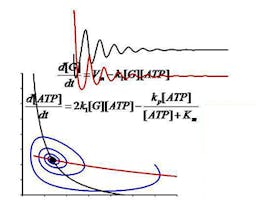This course gives an introduction to how to create genetic circuit models. These models leverage chemical reactions represented using the Systems Biology Markup Language (SBML). The second module introduces methods to simulate these models using ordinary differential equation (ODE) methods. The third module teach stochastic simulation methods. The fourth module introduces several variations of the stochastic simulation algorithm. Finally, the fifth module introduces genetic technology method that leverage computational analysis for selecting parts and verifying their performance.



Engineering Genetic Circuits: Modeling and Analysis
This course is part of Engineering Genetic Circuits Specialization


Instructors: Chris Myers
Sponsored by PKO BP
Recommended experience
What you'll learn
Design and analyze models of genetic circuits.
Simulate genetic circuit models using ODE simulation methods.
Simulate genetic circuit models using stochastic simulation methods.
Utilize genetic technology mappers to select parts for genetic designs.
Details to know

Add to your LinkedIn profile
16 assignments
See how employees at top companies are mastering in-demand skills

Build your subject-matter expertise
- Learn new concepts from industry experts
- Gain a foundational understanding of a subject or tool
- Develop job-relevant skills with hands-on projects
- Earn a shareable career certificate


Earn a career certificate
Add this credential to your LinkedIn profile, resume, or CV
Share it on social media and in your performance review

There are 5 modules in this course
This week will describe the basics of modeling biological systems using chemical reactions, how these models can be represented using the Systems Biology Markup Language (SBML) standard, and how these models can be constructed using software tools such as iBioSim.
What's included
23 videos6 readings2 assignments1 peer review
This module will introduce the theory and methods for the analysis of genetic circuit models using ordinary differential equations (ODEs). In particular, it will describe the classical chemical kinetic model, numerical methods for ODE simulation of these models, and techniques to analyze these ODE models qualitatively.
What's included
13 videos3 readings3 assignments1 peer review
This module will introduce stochastic analysis methods for genetic circuits. In particular, it will introduce the stochastic chemical kinetics model, Gillespie's Stochastic Simulation Algorithm (SSA) to analyze these models, and various alternative stochastic analysis methods. Finally, the module will conclude with some additional topics: the Chemical Langevin Equation, stochastic Petri nets, the phage lambda model, and spatial Gillespie methods.
What's included
20 videos4 readings4 assignments1 peer review
This module presents several variations on the SSA algorithm to solve particular analysis problems. In particular, the hierarchical SSA (hSSA) methods enable the analysis of large models, the weighted SSA (wSSA) methods allow for the analysis of rare events, and the incremental SSA (iSSA) methods enable the determination of typical behaviors.
What's included
18 videos4 readings3 assignments
This module presents various ways that modeling can be utilized in genetic circuit design to select parts for optimal performance.
What's included
21 videos4 readings4 assignments
Instructors


Offered by
Why people choose Coursera for their career




Recommended if you're interested in Physical Science and Engineering

University of Colorado Boulder

University of Colorado Boulder

University of Colorado Boulder

Icahn School of Medicine at Mount Sinai

Open new doors with Coursera Plus
Unlimited access to 10,000+ world-class courses, hands-on projects, and job-ready certificate programs - all included in your subscription
Advance your career with an online degree
Earn a degree from world-class universities - 100% online
Join over 3,400 global companies that choose Coursera for Business
Upskill your employees to excel in the digital economy


